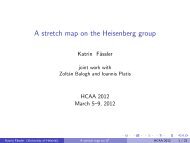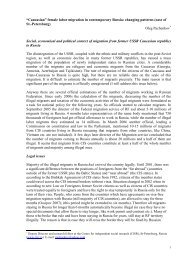Experiential metaphors in Latin - Wiley Online Library
Experiential metaphors in Latin - Wiley Online Library
Experiential metaphors in Latin - Wiley Online Library
You also want an ePaper? Increase the reach of your titles
YUMPU automatically turns print PDFs into web optimized ePapers that Google loves.
316<br />
TRANSACTIONS OF THE PHILOLOGICAL SOCIETY 109, 2011<br />
Figure 1. The STATES ARE LOCATIONS metaphor <strong>in</strong> Lat<strong>in</strong><br />
The employment of this metaphor with different verbs provides evidence for the productivity<br />
of the schema.<br />
A model for represent<strong>in</strong>g schematicity and productivity <strong>in</strong> <strong>metaphors</strong> has been worked out<br />
by Clausner & Croft (1997). Follow<strong>in</strong>g this model, I suggest the graphic representation shown<br />
<strong>in</strong> Fig. 1, to show the possible levels of schematicity and entrenchment of the STATES ARE<br />
LOCATIONS metaphor <strong>in</strong> Lat<strong>in</strong> and its subord<strong>in</strong>ate <strong>in</strong>stantiations. This metaphor is highly<br />
productive, because the most schematic level, where we f<strong>in</strong>d what I label a ‘Basic Event Type<br />
Metaphor’, is itself productive, as the boxes <strong>in</strong> bold show. Hence, the schematic metaphor<br />
placed at the highest level of generality is capable of extend<strong>in</strong>g its syntactic pattern (and its<br />
conceptual counterpart) to other, semantically related schema-specific <strong>metaphors</strong>. Some of<br />
them are productive also, and give rise to a number of low-level metaphor <strong>in</strong>stantiations (cf.<br />
<strong>in</strong> dubio sum fi <strong>in</strong> dubio haereo, <strong>in</strong> dubio iaceo, <strong>in</strong> dubio sto). The bold l<strong>in</strong>es symbolize these<br />
productive relations by means of which the general schema is actualised by different<br />
constructions at lower-level degrees of schematicity.<br />
It is worth not<strong>in</strong>g that the locative schema shows productive trends also at lower levels of<br />
schematicity. In the first case, the stimulus holds steady while the verb changes: for example,<br />
the <strong>in</strong> dubio sum schema extends its partially lexically filled pattern to other verb types, and<br />
one could take the fact that they share the same stative Aktionsart as an <strong>in</strong>dication that this<br />
case of metaphorical extension is basically motivated by aspectual factors. In another case, a<br />
metaphorical schema characterized by low schematicity s<strong>in</strong>gles out synonymous constructions<br />
by substitut<strong>in</strong>g the stimulus and ma<strong>in</strong>ta<strong>in</strong><strong>in</strong>g the basic verb esse. These novel forms are<br />
structurally and semantically similar, not to say identical, to the more schematic model, as <strong>in</strong><br />
the case of <strong>in</strong> timore esse <strong>in</strong> terrore esse. However, if the modelled item turns out to be a<br />
hapax, as <strong>in</strong> the case of <strong>in</strong> terrore esse, <strong>in</strong> maerore iacere, the relation which the<br />
superord<strong>in</strong>ate schema yields is only partially productive, and this situation is symbolised by<br />
dashed l<strong>in</strong>es.<br />
5. EVENTS ARE MOVEMENTS: AN EXAMPLE OF SEMI-PRODUCTIVITY IN LATIN METAPHORS<br />
The EVENTS ARE MOVEMENTS schema constitutes a specific <strong>in</strong>stantiation of the Event Structure<br />
Metaphor, which has been suggested by Lakoff and his associates <strong>in</strong> several works and<br />
subsequently studied <strong>in</strong> a number of languages, at least with<strong>in</strong> the cognitivist approach (see<br />
e.g. Lakoff 1993; Emanatian 1992; Boers 1996; Radden 1998). The po<strong>in</strong>t of studies such as<br />
Lakoff (1993) is that ‘various aspects of event structure, <strong>in</strong>clud<strong>in</strong>g notions such as states,<br />
changes, processes, actions, causes, purposes and means, are characterized cognitively via

















